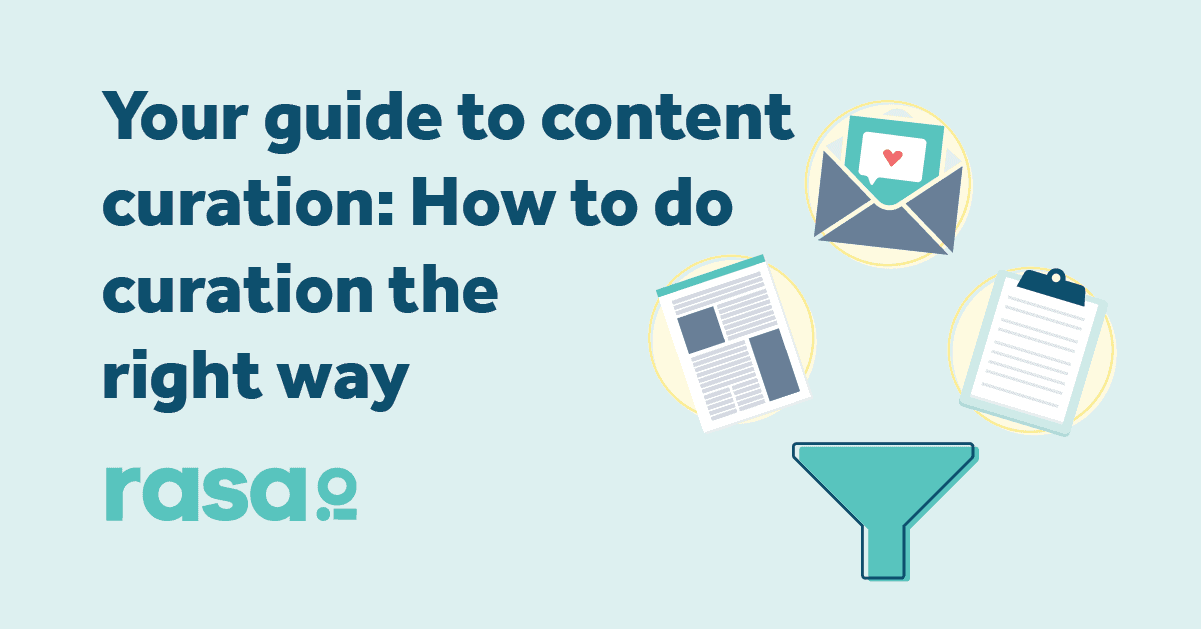Your audience wants to hear from your brand on a regular basis, but they don’t always want to hear about your brand. Striking that balance is the difference between a content marketing strategy that includes curated content, and one that does not.
How do you do content curation the right way? First, get familiar with the best practices of curation. Then it’s time to think about the content that your audience might like, where to find it and how to share it.
Here’s a step-by-step guide for getting started.
1.) Figure out what topics you will curate
The goal of content curation is to deliver the content that is most useful and valuable to your audience. Brands that do this well focus on sharing content clustered around a specific topic or set of topics related to their product or service. How do you pick what topics to focus on?
First, think about what your business does. What is your product or service? What topics do you find yourself reading about when you’re learning about your own industry? Your audience will be interested in some of that content as well.
Next, think about what your customers actually care about. This is different from what your business does, but the two can intersect. Your customers care about a lot of different things, from their health and well-being and that of their families to saving money. Your curation sweet spot is a blend of what you do and what your audience cares about.
Outdoor retailers like Patagonia, REI and Huckberry are great examples of how to achieve this blend. What do they do? They sell outdoor gear. In addition to gear, their customers really care about being outside, finding adventure and taking care of the Earth. The curated content those brands deliver includes video profiles of rock climbers, mountain bikers and fisherman; articles on climate change, developing sustainable wetsuit material and developments in federal conservation regulations; and guides to hiking trails and beaches. All of that content relates to their brand, even if it’s not about their brand.
Curate around topics that help your audience understand how your product can help them meet their needs, as well as topics that they genuinely care about.
2.) Pick reputable sources
The bulk of your curated content is going to be in the form of articles, videos and other content linked from external websites, blogs and social media feeds. The places where you look to find content are called content sources.
There are tons of places to get content online. Having a list of vetted sources makes the curation process easier and helps you avoid sharing content that is unreliable or that may reflect poorly on your brand. We cannot over stress the value of picking reputable sources.
Here are a few questions to consider as you start to build your source list.
- Is this source a trustworthy source
- Does the source publish new content regularly?
- Is it clear who is behind the blog, website or platform?
- Does the source meet the same quality standards as your brand’s original content, including proper spelling, grammar and punctuation?
- Is the source’s content easy to read?
Good sources to start gathering content from include news websites, industry or trade publications, and blogs run by companies you partner with.
3.) Develop a curation workflow
With a list of topics and content sources in hand, it’s time to start curating. If you’re curating content manually, think about how often you will be looking to share curated articles and links. Use that schedule to inform how often you will search for content and gauge how much you’ll need to gather. Do you want to look out for curated content for a few minutes each day? Or for 30 minutes on a specific day of the week?
If content curation is new to you, it may be helpful to dedicate time each week to look for content. Think about what your audience would find interesting when reading the news or an industry blog, and keep an eye out for interesting articles shared by other brands.
Next, plan how and where you will gather links to curated content. To start, it could be as simple as bookmarking links and gathering links in a specific folder.
Here are a few other ways to start finding content.
- Create lists on social media. Build Twitter lists around specific topics or hashtags, and follow specific hashtags on Instagram and Facebook. Your general feed is noisy; creating lists allows you to home in on the content that matters most to your audience.
- Join niche groups. The internet is filled with groups, forums, message boards and clubs that focus on specific interests. Find the groups your audience members are most likely to be members of and join the conversation. Be respectful of the group dynamic; the goal here is to listen, not to spam groups with promotions from your brand.
- Use Google Alerts. Use Google search to sign up for alerts on topics your readers care about. A word of advice: Set very specific search parameters, otherwise your inbox will be flooded. Also, be sure to click through and read content served up by Google before sharing it to make sure it meets your sourcing standards.
- Sign up for email newsletters. Sometimes curated content comes from other curators. Subscribe to email newsletters from other brands in your category, as well as newsletter that aggregate news or focus on a specific interest. Don’t be afraid to share announcements from other companies if you think it might be useful to your audience.
4.) Assemble a curation toolkit
If reading this and feeling overwhelmed, it may be worth considering adding curation software to your content marketing toolkit. Curating content by hand is doable, but it’s hard to scale. And scale is what you need to establish yourself as a trusted source of information.
There’s a range of tools available to help ramp up your curation efforts, including:
And we’d be remiss if we left out rasa.io. Our platform has built-in curation features that make it easy to deliver curated content via email newsletter.
5.) Plan out how to share content
Once you’ve assembled curated content think about how you want to share it with your audience. Is the content best suited for social media? Or as a link in your email newsletter? Perhaps you want to share a roundup of the week’s most interesting curated content in a weekly blog post?
There’s going to be a lot of overlap here. Don’t be afraid to share the same curated content on social media as you do elsewhere, though you’ll want to tailor your posts to each platform. For example, you always want to provide context and commentary with the curated links you share, but that context will have to be shorter and snappier to fit in a short tweet versus a post on Facebook or your blog.
Think about how often you want to share curated content. You don’t want to overshare, but you also need to be consistent. For most businesses, how frequently you share content depends on the platform. Social media feeds refresh often, making it possible to share curated content every day without getting on your audience’s nerves. For other platforms, like newsletters or blogs, consider sharing curated content at least once a week.
Also, think about how much curated content you are sharing in relation to original and promotional content. There are multiple ways to approach this mix, but a general rule of thumb is to fold a healthy amount of original content into your curated content. Messages that only promote your brand should be the smallest slice of your content marketing pie.
Here are two approaches for thinking about your content mix.
- The Golden Rule. This guideline is also known as the 30/60/10 rule. That stands for 30% original content, 60% curated content and 10% promotional content. In this mix, curated content is the bulk of day-to-day content, while original content, like blog posts, get about half as many shares.
- The 5:3:2 Rule. This rule is geared specifically for social media. For every 10 posts, share five pieces of curated content, three pieces of original content and two pieces of content that are fun and personal. The idea with the last two posts is to make a concerted effort to humanize your brand.
6.) Track performance
Congrats! Now that you’re curating content like a pro, it’s important to track the results of that work. Each blog post read, social media share, and email click-through gives you a clearer picture of what your audience is interested in. Pay attention to trends, and use that information to further refine the topics and content you pay attention to when curating.
Here are a few tools to help you get started on tracking how your content is doing.
- Google Analytics. This is the most popular tool for tracking website and content performance with good reason — it’s free and it works. This tool allows you to dig into the demographics of your audience, where they’re coming from and what content they’re clicking on. You can also use it to measure the effectiveness of social media campaigns.
- Facebook Page Insights. Also free for business profile users, this tool allows you to gather information on what actions your audience is taking on your Facebook page, including post engagement (i.e. likes, comments, shares) and audience data, like when your followers tend to be online. It also shows you what types of posts are doing well on pages similar to yours.
- Instagram Insights. Similar to Facebook’s analytics page (Facebook owns Instagram), your Instagram Insights page lets you dig into data on your most popular posts and your overall reach. Unfortunately, there’s no desktop version of this tool. It’s only available for use by business account holders in the mobile app.
- Twitter Analytics. You have to be a paid advertiser on Twitter in order to start using its analytics page, but the tool has useful features. Among other data, it gathers your top tweets, engagements and impressions over time, which can help you see what content could be repurposed at a later date.
Check out our list of best practices
There you have it! A full, step-by-step guide to curating content. Still wondering about curation best practices? See our list of curation dos and don’ts.
Free download: The Straight Talk Guide to Content Curation
The Straight Talk Guide to Content Curation [Free Download]












